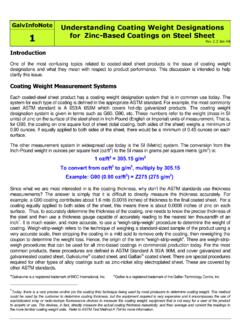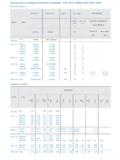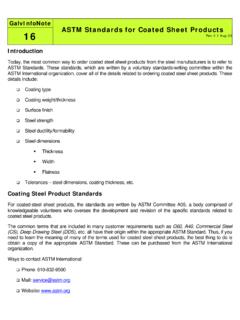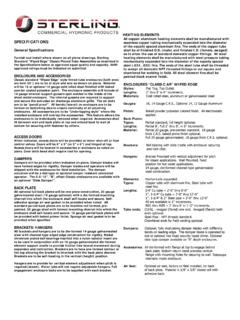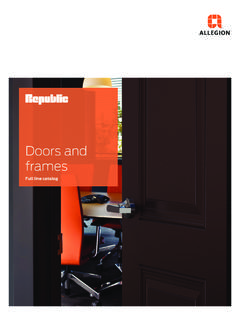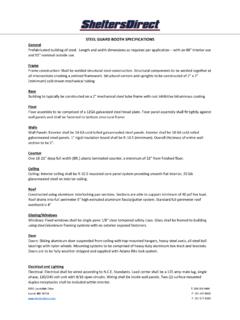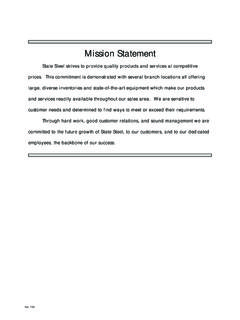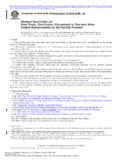Transcription of Zinc Phosphate Treatments for Painted 18 …
1 GalvInfoNote zinc Phosphate Treatments for Painted galvanized & galvannealed sheet Products 18 Rev Aug-03. Introduction Typically, it is difficult to achieve good adhesion between a paint coating and fresh galvanized sheet . For this reason, it is customary to apply some type of intermediate layer, a pretreatment, to develop good long-term performance. Not only does the pretreatment improve the mechanical adhesion between the paint and the zinc coating, but it also improves the resistance to blistering and loss of paint adhesion during exposure to corrosive environments. In the case of galvannealed steel sheet , the need for a pretreatment to achieve good initial paint bonding is less critical, but a pretreatment is still beneficial to achieve good resistance to loss of paint adhesion when the product is exposed to a corrosive environment.
2 zinc Phosphate Treatments The most commonly applied paint pretreatment for developing good bonding qualities between paint and the galvanized or galvannealed coatings on steel sheet is zinc Phosphate . In addition to the excellent effect that a zinc Phosphate coating has on paint adhesion, it also aids to decrease, often dramatically, the tendency for paint disbondment during subsequent atmospheric exposure in a corrosive environment. zinc Phosphate coatings can be applied to the galvanized sheet while it is in coil form by either the steel manufacturer or a coil coater (manufacturer of prepainted sheet ), or it can be applied to the cut sheet or fabricated article by the end-use manufacturer. The usual zinc Phosphate process involves several steps, both if the coating is applied on a coil line or by the part manufacturer.
3 If there are oils present on the surface of the galvanized or galvannealed steel, the first step is the removal of the oil by degreasing. This might involve cleaning with the use of an aqueous, alkaline cleaning solution or by other forms of degreasing with the use of solvents. Preferably, if the phosphating is done on a coil- processing line, the next step involves the use of a conditioning stage; the application of a titanium Phosphate conditioner to prepare the galvanized / galvannealed surface for the development of a superior zinc Phosphate coating. The titanium Phosphate aids in the development of a uniform Phosphate coating with small zinc Phosphate crystals by depositing sub-micron size particles which act as seeds to promote the growth of zinc Phosphate crystals on the surface of the galvanized sheet .
4 After conditioning, the zinc Phosphate coating is applied by immersion in a zinc Phosphate solution or by spraying zinc Phosphate solution onto the surface of the galvanized or galvannealed sheet . During the time that the sheet is in contact with the aqueous solution of the Phosphate , the acidic zinc Phosphate actually dissolves a small amount of the galvanized ( zinc ) coating. At the surface of the galvanized coating, the acid attack of the zinc Phosphate solution produces a localized increase in the pH resulting in the precipitation and deposition of insoluble zinc Phosphate crystals on the surface of the galvanized coating. After allowing the reaction to take place for some time, this crystallizing action leaves behind a continuous, relatively thick solid film of zinc Phosphate on the surface of the galvanized or galvannealed sheet .
5 After the desired zinc Phosphate film weight is deposited, the steel is removed from contact with the zinc Phosphate solution and then rinsed thoroughly and dried. The zinc Phosphate coating may receive a final post rinse after the solution is washed off. Typically, the final rinse contains chromates for enhanced corrosion protection. GalvInfoNote #18. Rev Aug-03. The steps in a 6-stage zinc phosphating operation might include: q Alkaline precleaning q Water rinse q Titanium activator rinse q Application of the zinc Phosphate solution q Hot water rinse q Chromic acid rinse The total cycle might take several minutes. For example, the spray phosphating time might be of the order of 3. minutes to develop a film weight of 150 to 300 milligrams/ft2 of surface area.
6 For coil-line phosphating, typical phosphating times are in the range of 5 to 10 seconds. To accomplish the development of the preferred fine zinc Phosphate crystalline surface, it is important to pay attention to the specified temperatures, times, and chemical concentrations in each of the above stages. When zinc phosphating is done properly, the resultant paint adhesion is greatly improved. The first way the product is improved is that the somewhat rough and porous Phosphate film allows for mechanical keying between the Phosphate and the paint. The substantial quantity of oxygen in the Phosphate film also allows for chemical bonding (hydrogen bonding) to occur between the paint and Phosphate coating. But, perhaps more importantly, the zinc Phosphate coating helps to reduce the rate of paint undercutting at areas where the integrity of the paint is destroyed, such as along sheared edges, scratches in the paint, etc.
7 To further describe this benefit (reduced rate of paint undercutting corrosion), consider a Painted galvanized surface. If the paint is damaged, the natural tendency is for the corrosion reaction to undercut the paint and move laterally along the sheet surface by corroding and dissolving the galvanized coating. This, in turn, breaks the bond between the paint and the sheet , and the paint spalls off. This is one typical pattern for loss of paint adhesion during exposure to the environment. A well-developed zinc Phosphate pretreatment slows down this lateral rate of undercutting corrosion, and a considerably longer product life results.. Copyright 2003 ILZRO. Disclaimer: Articles, research reports, and technical data are provided for information purposes only.
8 Although the publishers endeavor to provide accurate, timely information, the International Lead zinc Research Organization does not warrant the research results or information reported in this communication and disclaims all liability for damages arising from reliance on the research results or other information contained in this communication, including, but not limited to, incidental or consequential damages.
